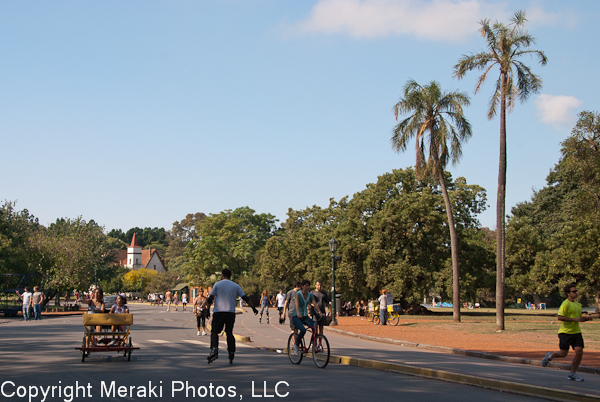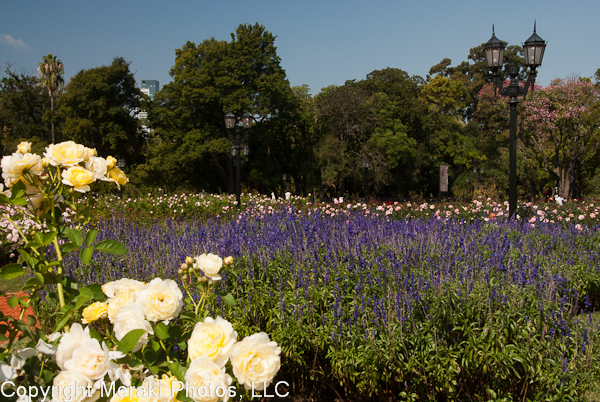Buenos Aires charmed American expat Tina so much that what was only supposed to be a short vacation turned into a decision to live and work - and dance! - there...for the time being, at least. Tina shares what she enjoys about everyday life in Argentina's capital city and offers some tips on adjusting to the local culture.
-Where were you born?
Seattle, WA - USA
-In which country and city are you living now?
Buenos Aires, Argentina
-Are you living alone or with your family?
I came alone and I live with roommates.
-How long have you been living in Argentina?
I landed on Feb 2, 2008.
-What is your age?
31
-When did you come up with the idea of living in Argentina?
I originally came here to spend a one-month vacation (dancing tango and seeing friends). I knew by my second day that I was going to stay longer than a month. It's such an easy city to settle into and I didn't want this to just be a vacation. So I extended it to three months, which turned into six months, and then I decided to just stay put.
-Was it hard to get a visa or a working permit?
I'm here on a tourist visa like a lot of others who live here. Have to renew every three months.
-How do you make your living in Argentina? Do you have any type of income generated?
I am a freelance translator (from Italian to English) and I work online. I already had my work with me when I came (via my laptop) which is why I think it was so easy for me to stay. I knew I could be productive and be in a place that I love at the same time. You can't beat that!
-Do you speak Spanish and do you think it's important to speak the local language?
Yes, now I do speak Spanish. Not perfectly but I speak it. I came here once before, in Feb 2007 and took some Spanish lessons, but this time around I just got out there and started speaking. I'm fluent in Italian, so it was easy to pick it up. I'm able to make friends, hold conversations comfortably, etc. Sometimes the accent here is baffling but for the most part, I get it.
I think it is so important to do your best to learn the local language no matter where you go. Speaking the language has opened so many doors for me, both here and in Italy. Armed with the local language, you get to have people in your life who you would not otherwise know. And it just feels so good to be able to do your errands and negotiate and get directions without doing too many charades (which, even with Spanish, I still tend to do. It must be the Italian in me.)
-Do you miss home and family sometimes?
This is my 3rd time living abroad and I can definitely say that yes, I miss Seattle (and Italy) and my family sometimes. I miss the salty sea air and Pike Place Market, my family, good olive oil, international wine selections... I danced Tango in both Seattle and Italy and even though I have the best Tango in the world at my fingertips here in Buenos Aires, it makes me miss my friends back home who came into my life through Tango.
-Do you have other plans for the future?
I'd like to live in Italy again in the future. I am waiting for my Italian citizenship (I have lost track of how long) and once I have that, I will start thinking about it. I was supposed to go sooner (this September) but I just can't bring myself to leave Buenos Aires and I'd rather wait until I have citizenship so I can go as an Italian, instead of having to go through all the Visa stuff. It will be a while.
-What about housing, have you bought, or are you renting a home? How much do you pay for it?
I am renting in a large apartment (in my opinion it's more like a house!) with 4 roommates. It's very spacious and I think only two people are home at any given time. I have managed to save money by sharing a place.
-What is the cost of living in Argentina?
It really depends on which barrio you live in and what your day to day needs are.
Also, sadly, due to constant hyperinflation, any figure I give you today will be obsolete in the near future.-What do you think about the Argentineans? I find people here to be genuine (instead of "fake nice"), hard working, welcoming, very straight forward, and very Italian.-What are the positive and negative aspects of living in Argentina? Positives:The produce here is out of this world. The best grapefruit and oranges I've ever had. The leafy greens here are amazing - they have so much more substance and texture than the supermarket greens in the US. I can buy my produce from one of the many verdulerias (green grocers) and most of the time the vegetables still have their roots intact, dirt & all. It feels so real. The beef is wonderful too - not pumped full of steroids, and it's grass fed as it should be. The sweets here are gorgeous - anything with dulce de leche! The Tango is another huge positive here. It's the best dancing I've ever experienced. The cafe culture is very special to me - I admire the people's ability to just sit down and savor the experience of having coffee with a friend. You can sit for hours with just one cafe con leche and the waiters will not bother you. The public transportation is great, albeit a little tricky to use. There are always people out, walking on the sidewalks, in parks, sitting in cafes - it's a city that is very much alive.Negatives: Sharing sidewalks with the locals. I get so frustrated sometimes walking down the street. People don't get out of each other's way and there's a lot of people-dodging going on. Never count on being able to get somewhere fast if you're walking, because you'll most likely get stuck behind somebody who keeps getting in your way. Aah! There is a lot of harsh reality here, and you have to be a sensitive and grounded person to be able to deal with it. Yes it's a "fun" expat life where you can do just about anything but there are plenty of others who are not so fortunate. People have to work hard to keep up (just barely) with continuous hyperinflation. On the roof of a restaurant not too far from my apartment, is a small cluster of tin shacks that people live in. There are cartoneros at night who rummage through the garbage to take out recyclables which they turn in for a small stipend. There are a lot of abandoned buildings that I'm sure were once beautiful but now have fallen to decay. Argentina has been through a lot in the past century and there is evidence all around. I look at it as a reminder to not complain. The dog-doo on the sidewalks. I'm always looking down for fear that I'll step into something. The pressure on women to starve themselves and have plastic surgery.-Do you have any tips for our readers about living in Argentina? Learn Spanish. Be sensitive to the fact that most people here do not have the luxury of dividing the prices by 3. Eat flan con dulce de leche for dessert and don't feel the least bit guilty. Be prepared to be overwhelmed. It is an intense city where a lot of things are going on at the same time. Just take it easy and try to soak it all up. When all else fails, eat helado. Keep up with the current events here - there is always something happening and it will affect your daily life.








